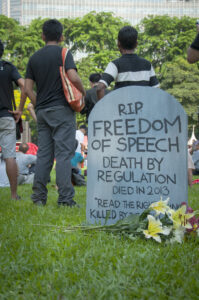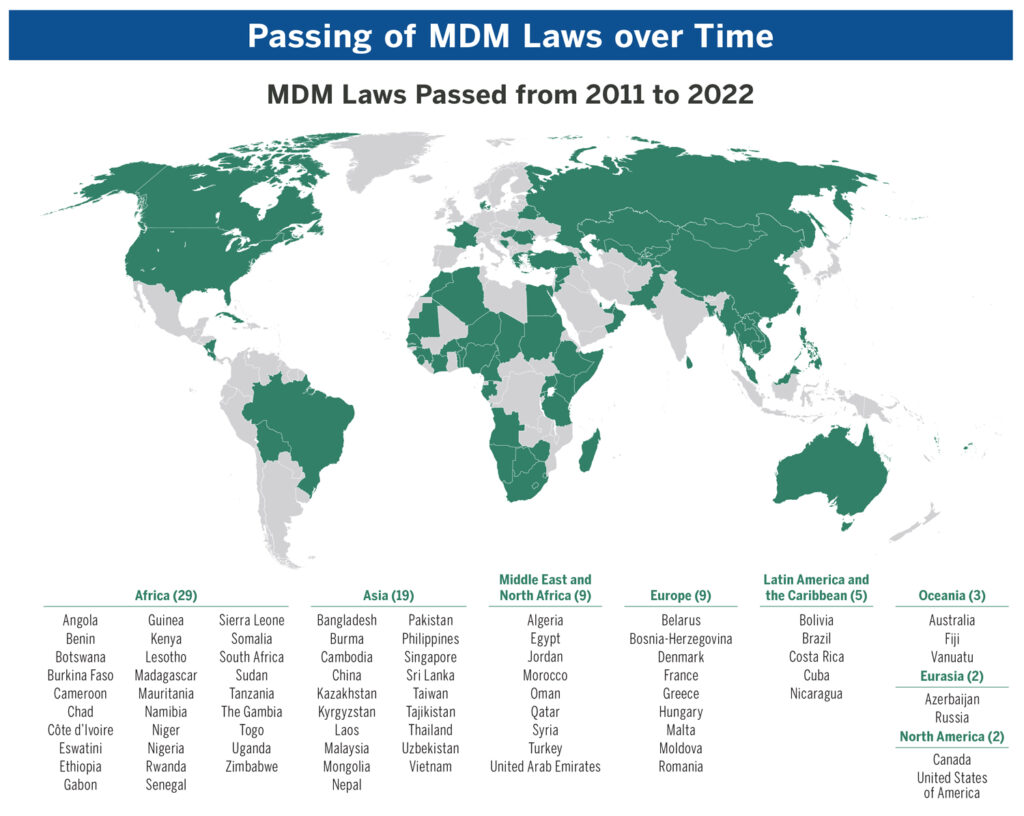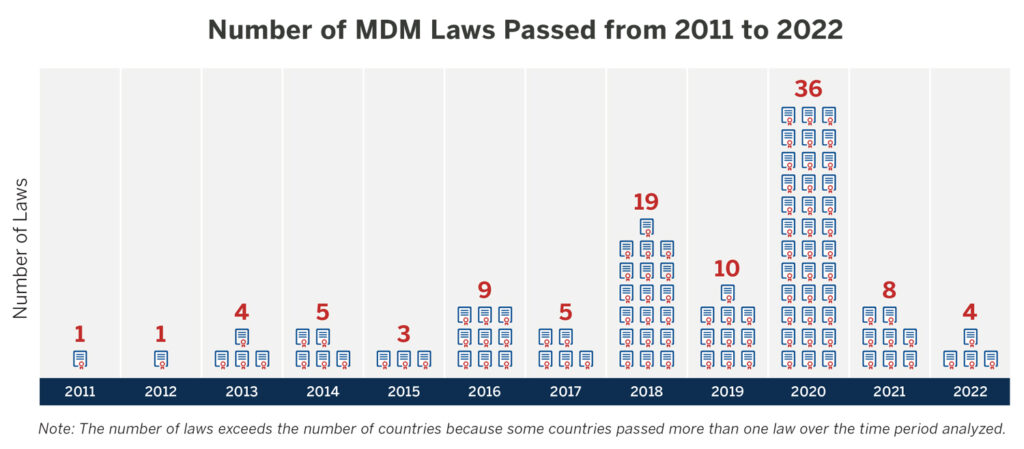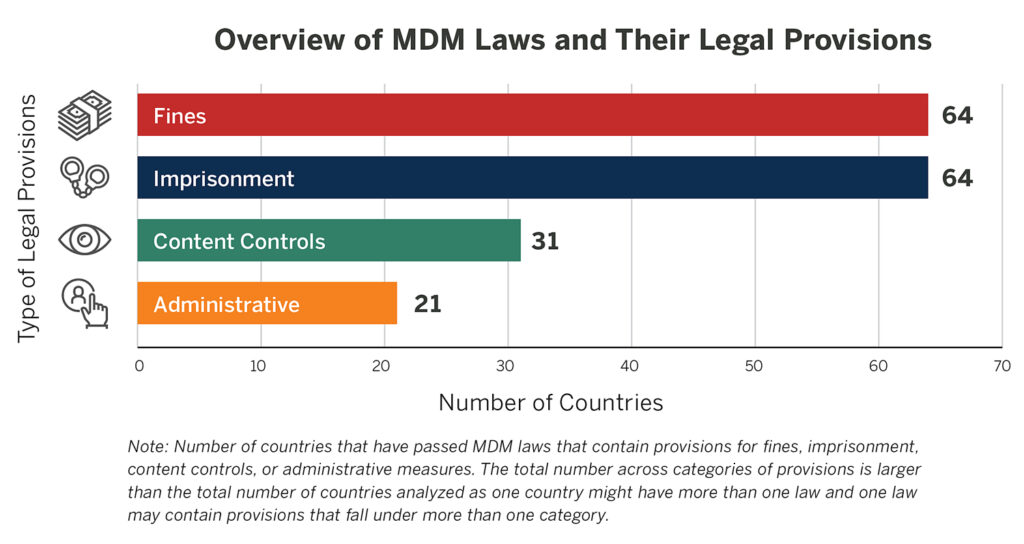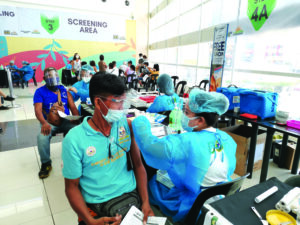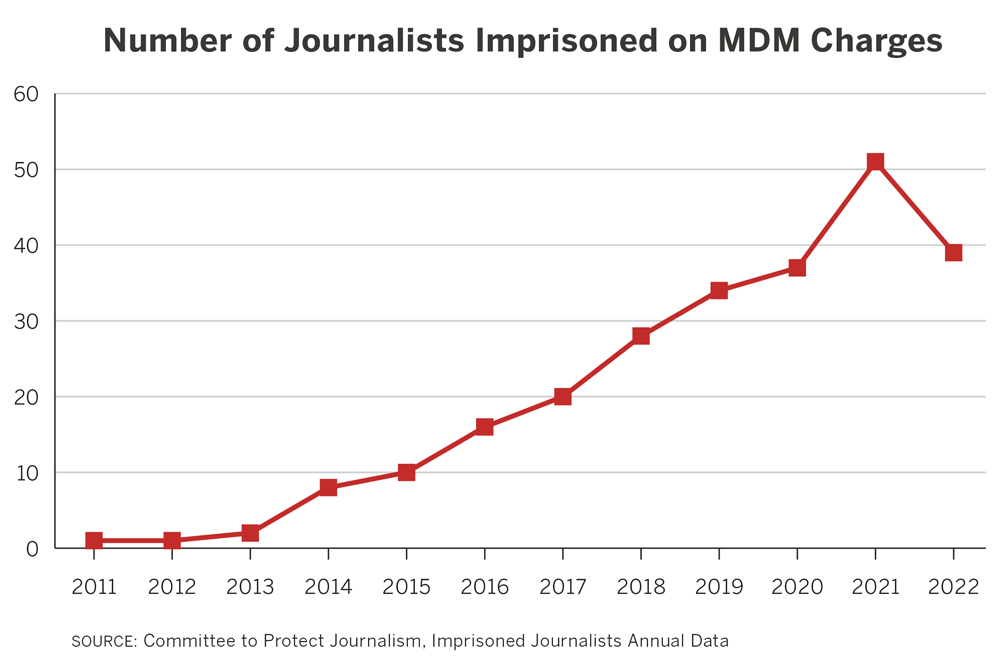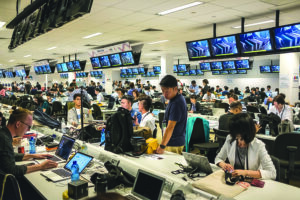Key Findings
Between 2011 and 2022, 78 countries passed laws designed to limit the spread of false or misleading information on social media. Some of these laws focus on improving platform transparency and accountability in digital advertising or increasing media and digital literacy. However, many focus on the content itself, criminalizing the creation and distribution of “fake news.” As a result, many misinformation, disinformation, and mal-information (MDM) laws chill press freedom, rather than enhance it. Although it is important to recognize that not all legal and regulatory responses to MDM have negative consequences for press freedom, the trajectory of recently passed MDM laws shows that many responses trend toward repression.
– MDM laws are being enacted at an escalating rate. Between 2011 and 2015, only 14 MDM laws were implemented. Between 2016 and 2022, 91 such laws were put in place.
– MDM laws are often vague and allow governments to define prohibited content at their own discretion. As a result, journalists risk steep fines or even imprisonment for any content that goes against the government line.
– In many countries, countering false information is framed as an issue of national security. In authoritarian states, this can pose a real threat for independent media. To adequately address MDM, a more holistic approach is necessary.
Introduction
The spread of misinformation, disinformation, and mal-information (MDM) online has become one of the most pressing issues of our time. Around the world, people have been inundated with false, misleading, and deceptive information about health, politics, and science. Journalists are on the front lines of these digital battles over truth, working to provide citizens with accurate news and information. However, in the “post-truth” era,1 independent journalism faces enormous constraints with governments passing legislation to combat the threats of misinformation and “fake news,” which both intentionally and inadvertently impinge upon freedom of the press. These measures can sometimes interfere with the free and open exchange of ideas, as well as citizens’ ability to hold leaders to account.
Since 2011, MDM laws have been on the rise, with the greatest increase seen during the COVID-19 pandemic. Seventy-eight countries have passed laws designed to limit the spread of false or misleading information. Some of these laws focus on improving platform transparency and increasing media literacy. However, many of them criminalize the creation and distribution of “fake news.” Such laws often lack definitional specificity and can lead to greater overreaches of power. As such, they can have long-term consequences for freedom of the press and other human rights online.
Indeed, many MDM laws have already been used to arrest citizens and journalists for publishing or sharing false information online. According to the Committee to Protect Journalists, almost 400 reporters were imprisoned around the world in 2022. Of those, 39—nearly 10 percent—were jailed on MDM charges.2 Although human rights activists and academics have focused on how MDM laws can limit freedom of expression, less attention has been paid to freedom of the press and the consequences of these laws for independent journalism around the world.
Our analysis of the 105 MDM laws identified four types of legal penalties embedded in these laws that could potentially hinder press freedom:
1. Excessive monetary fines, which impose a range of financial penalties on journalists or media organizations
2. Imprisonment, which involves arresting and imprisoning journalists and editors
3. Content controls and corrections, which require journalists and media organizations to remove content or post state-approved corrections
4. Increased administrative burdens, which include measures like licensing regimes, data localization, transparency requirements, or mandated press or media councils
Special rapporteurs on freedom of expression have individually and collectively issued several declarations on how laws purporting to combat misinformation or false information run afoul of international human rights standards.3 They contend that “general prohibitions on the dissemination of information based on vague and ambiguous ideas, including ‘false news’ or ‘non-objective information,’ are incompatible with international standards for restrictions on freedom of expression . . . and should be abolished.”4 Legal restrictions on freedom of expression must be narrowly circumscribed, serve a legitimate purpose as recognized by international law, and impose proportionate punishments consistent with that legitimate purpose. Many of the laws examined in this report do not adequately satisfy those criteria.
It is important to emphasize that not all regulatory approaches for combatting MDM have negative consequences. Some policies can strengthen journalism in the digital era. For example, transparency laws that improve platform transparency or invest in media literacy can help bolster democratic processes and institutions. However, many regulatory approaches to combating MDM focus on criminalizing false content, which can be problematic. First, there is a concern about subjective interpretation and selective enforcement, which can be used to suppress dissenting voices or independent journalism. Second, it could lead to increased self-censorship as journalists fear reporting on issues that might get them in legal trouble.
As social media companies have seemingly failed to adequately address challenges related to the spread of misinformation, governments are increasingly looking to regulatory interventions. However, regulatory approaches that focus on criminalizing MDM can negatively impact press freedom by creating an environment that chills and censors independent journalism. They can also set a dangerous precedent for autocratic leaders who wish to legitimize domestic censorship. Freedom of the press is essential to democratic institutions, such as a free and open debate and public accountability, and therefore it is vital to consider how MDM legislation can affect independent journalism.
Digital Authoritarian Practices
Despite the potential of digital technologies to foster press freedom and other fundamental rights, they also raise numerous challenges and risks. Just as activists and journalists have learned to use technologies to support social movements and the free flow of news and information, illiberal and authoritarian governments have learned to stifle, control, and suppress human rights online.5 Digital authoritarianism is “a way for governments to control their citizens through technology, inverting the concept of the internet as an engine of human liberation.”6 It differs from traditional forms of authoritarianism in that it is enabled and facilitated by advances in technology, which allow governments to exert control and influence on a large scale and in real time. It is important to note that digital authoritarianism does not only apply to illiberal or authoritarian governments but should be recognized as a broader set of practices that can be adopted regardless of regime type. This report focuses on digital authoritarian practices, which are applied to control the information environment and limit the expression of human rights.
 Research on digital authoritarian practices describes the many ways governments use digital technologies to monitor citizens, suppress dissent, and spread propaganda. Sometimes described as “information controls” or “digital repression,” governments use digital technologies to manage and curate information online.7 Some of these tactics focus on the co-option of technical measures—such as blocking, filtering, redirecting, or cutting off access to the internet entirely.8 Laws and regulations are other forms of information controls used to shape the information environment. While all governments regulate internet content in some way, a digital authoritarian approach might criminalize unfavored activity to limit fundamental human rights.9 Finally, information controls not only focus on limiting or restricting information, but also involve the dissemination of content, such as government propaganda to manipulate public opinion or undermine dissenting voices.10
Research on digital authoritarian practices describes the many ways governments use digital technologies to monitor citizens, suppress dissent, and spread propaganda. Sometimes described as “information controls” or “digital repression,” governments use digital technologies to manage and curate information online.7 Some of these tactics focus on the co-option of technical measures—such as blocking, filtering, redirecting, or cutting off access to the internet entirely.8 Laws and regulations are other forms of information controls used to shape the information environment. While all governments regulate internet content in some way, a digital authoritarian approach might criminalize unfavored activity to limit fundamental human rights.9 Finally, information controls not only focus on limiting or restricting information, but also involve the dissemination of content, such as government propaganda to manipulate public opinion or undermine dissenting voices.10
While none of these tactics is necessarily new, digital technologies can enhance the scale and overreach of governments controlling the information environment. Frequently, these tactics are employed under the premise of protecting public safety or for national security reasons, in effect “securitizing” the problem—be it misinformation, terrorism, or any other social concern. Once securitized, this allows the government to take on exceptional measures. Though not all MDM laws are passed with the intention to curtail freedom of expression or centralize the control of information, they do introduce an opportunity for governments, often under the guise of safety and security, to stifle independent journalism.
Misinformation Laws and Their Consequences for Press Freedom
Examining a broad scope of new laws to combat misinformation and disinformation globally, passed between 2011 and 2022, allows for an analysis of how such legal measures affect freedom of the press. The dataset used in this report was built in two parts, first by reviewing a collection of existing databases about government responses to mis- and disinformation,11 then surfacing additional examples and data through a systematic content analysis of news articles, think tank reports, academic articles, and legislative proposals for 178 countries and territories. We included laws and bills in the dataset based on the results of a key word search of several databases to find laws in each country that include the terms “fake news,” “misinformation,” “disinformation,” or “false information.” This surfaced a wide variety of laws and regulations designed to combat MDM.12
Between 2011 and 2022, 105 laws to combat MDM were imposed across 78 countries. Between 2011-2015, only 14 laws were adopted that explicitly mentioned sharing or publishing false information. In contrast, between 2016-2022, 91 laws were enacted or amended to include provisions regarding false or misleading information. In 2020 alone, 36 new MDM laws were passed, which is indicative of heightened government concern regarding information amid the COVID-19 pandemic.
It is important to note that not every country needed to pass new legislation to combat MDM because old laws were sufficient to prosecute individuals. For example, in Iran, journalists are frequently jailed and punished for spreading misinformation online. But these prosecutions are often made under long-standing defamation laws or under the realm of secret courts that lack due process and transparency.13 Other countries, like Malaysia, have passed and repealed MDM laws. However, old laws are still frequently used to prosecute individuals for spreading false information online.14
Also, not all of the laws identified have impacted press freedom. But the majority of laws passed by governments are content-specific, focusing on the creation and distribution of MDM, rather than other legal or regulatory mechanisms that focus on increasing digital literacy or improving platform accountability and transparency.
Excessive Fines and Monetary Penalties
Fines are the most commonly imposed penalty for creating or sharing misinformation, with varying levels of enforcement, targeting individuals, company executives, media organizations, or social media platforms. Certain penalties may be applicable based on qualifiers such as the number of followers or the size of a media organization or platform before they come into effect. For example, under France’s 2018 La Lutte Contre la Manipulation de l’Information (The Fight Against Information Manipulation), an individual who engages in the widespread and rapid dissemination of MDM could pay up to €75,000 ($80,300).15 Whereas, in Ethiopia under the Hate Speech and Disinformation Prevention and Suppression Proclamation No. 1185/2020, an individual can be fined up to 100,000 birr ($1,860) if they spread disinformation on social media and have more than 5,000 followers.16
For an independent news outlet, a fine may become debilitating. For example, Malaysian publisher Malaysiakini was fined 500,000 MYR (approximately $124,000) for comments left by readers on one of its articles, which courts found “spurious” and “untrue.”17 Fortunately, through crowdfunding efforts, the outlet was able to pay the fine.18 It should also be noted that the use of monetary penalties spans both liberal and illiberal states. Within the dataset, countries across the spectrum of democracy, as classified by the Varieties of Democracy database, passed MDM legislation with monetary penalties.19
Case Study: Fining the “Infodemic”
The COVID-19 pandemic significantly impacted press freedom in many countries around the world. Journalists faced a range of threats, including intimidation and harassment, for covering issues pertaining to the pandemic.20 During the pandemic in 2020 and 2021, 17 national governments passed laws that prohibited sharing news and information about COVID-19.21 Some of these laws fine individuals for publishing “false” news and information about COVID-19.22 For example, in Singapore, the government passed a law that fines individuals up to 50,000 SGD ($37,000) for spreading false information about COVID-19. Similarly, Russia passed legislation in the wake of COVID-19 that made it a criminal act to “publicly disseminate disguised as truthful knowingly false information about circumstances threatening life and safety of citizens and/or measures to ensure safety of the populace and areas, of ways and methods of protection from such circumstances.”23 Russian journalist Aleksandr Pichugin was fined for “falsely” claiming in a Telegram post that an Orthodox church was responsible for superspreader events.24 Elsewhere, fines have been levied against journalists and media outlets for spreading “false” information about COVID-19 in Tanzania,25 the Philippines,26 and Egypt.27
These laws often include a provision for imprisonment alongside monetary policies. For instance, in the Philippines, the Bayanihan to Heal as One Act, an emergency legislation designed to combat COVID-19, stipulates that those found guilty of creating or spreading false information about the pandemic could be fined from 10,000 to 1 million Philippine pesos (around $180-$18,000) or imprisoned for up to two months.28 Analysis into the impact of these measures has found that more than 300 people have been arrested for spreading misinformation about COVID-19.29 For example, in Morocco, police arrested a dozen people for spreading misinformation about COVID-19, including citizens who used social media outlets to make claims that COVID-19 does not exist.30 Though the impact of fines will be context dependent, arrests will almost certainly impact the daily and long-term operations of news outlets as legal battles may drag on for years, taking both a financial and emotional toll on the organizations and individuals themselves.
While these laws are ostensibly designed to help limit the spread of harmful or misleading information about COVID-19, they also carry significant consequences for freedom of the press, as governments can apply these legal mechanisms to suppress or silence journalism and voices critical of government action or inaction.
Criminalization and Incarceration
The second most common penalty that appeared in the laws analyzed involved imprisonment for publishing or spreading MDM. This is not surprising, as it is one of the oldest forms of information control, predating the internet. For example, under Cambodia’s 2018 Joint Directive, someone found guilty of sharing false information could face imprisonment for up to two years.31 Similar to fines and other monetary penalties, the justification for imprisoning those who spread what the government deems to be MDM varies depending on the political environment or security concerns. For example, following the full-scale invasion of Ukraine by Russia in February 2022, Russia passed additional MDM laws aimed specifically at content regarding practically any government body, including the Russian Guard, Russian embassies, and the military, that they deemed false or misleading.32 This broad piece of legislation builds on existing laws that criminalize false information, exacerbating an already dangerous and fearful climate that induces self-censorship among Russian journalists, whether living within Russia or abroad.33
Under these new laws, many journalists have already been arrested. For instance, in 2018 the Egyptian government jailed more journalists under MDM laws compared with any other country in the world, with 19 people arrested.34 Following Egypt, Cameroon arrested four journalists, Rwanda three journalists, and China and Morocco both arrested one journalist.35 In the same way that the number of laws enacted has increased rapidly, the number of journalists jailed on MDM charges has risen steadily over the years. According to the Committee to Protect Journalists (CPJ), a total 22 journalists were imprisoned on MDM charges between 2011 and 2015. Between 2016 and 2022, that number shot up to 225.36
Imprisonment and the threat of imprisonment for publishing misinformation can have strong implications for press freedom as they can have a widespread chilling effect, not just on other journalists but on civic participation and civil society as well.37 Cases are often drawn out in public and covered in a biased manner to prevent others from considering voicing comments or criticism the government finds inappropriate or “fake news.”
While a government is not likely to arrest everyone online who engages in posting what it deems to be false or misleading content as that may be logistically impossible, such public cases can nonetheless send a signal to society at large and impact free expression and public debate. Such lawsuits often involve a large disparity in resources, diverting important resources away from civil society while undermining freedom of the press for those who do not have the ability to fight lengthy legal battles.38 For countries that do not have direct control over social media companies or the technological capacity to remove or block content themselves, arrests and imprisonment provide an alternative nontechnical route to controlling the information ecosystem.
It should also be noted that imprisonment as a sanction for spreading MDM is not limited to just illiberal or authoritarian regimes. Countries that rank high in democratic norms and processes have also adopted these laws. In Denmark, for example, a 2019 amendment to the penal code criminalized the dissemination of disinformation that “aids or enables” a foreign state actor to influence public opinion with a maximum penalty of 12 years imprisonment.39 While these laws are often embedded in a strong system of checks and balances, legal protections, and rights-enforcing mechanisms and oversights, they may nonetheless give impetus or justification for less liberal states to pass similar legislation. What makes regulatory approaches to MDM a complex issue is that illiberal regimes may co-opt laws developed in systems with strong checks and balances to legitimize their own authoritarian practices.
Forced Content Removal and Corrections
A third category of penalties and requirements can be grouped under content removal and corrections, which entail compelling publishers, social media platforms, internet service providers, or users to remove offending content or provide a mandatory correction. These types of penalties and requirements span all media systems and are not limited to the internet. For example, under Egypt’s 2018 Law on the Organization of Press, broadcasts can be banned or suspended by the government if they spread “fake news.”40 Tanzania’s Electronic and Postal Communications (Online Content) Regulation prevents online service providers from releasing so-called prohibited content, which includes false content that is likely to mislead or deceive the public.41 These types of requirements and penalties can therefore affect the user as well as providers and publishers.
While content controls often focus on the removal of content, some countries have also introduced laws that compel platform companies to leave content up or label content in a certain way. For example, in 2022, President Jair Bolsonaro of Brazil signed a decree, now overturned, that temporarily banned social media platforms from removing certain kinds of content, including content identified by social media platforms as misinformation about COVID-19 and the country’s upcoming presidential election.42
Case Study: Compelled Speech and Forced Corrections
While content removal, website blocking or filtering, and other means of preventing access to content have been mainstays of online censorship and information control, concerns over false information have also sparked compelled speech. Compelled speech is the transmission of speech required by law. Such laws typically require some form of mandatory apology or correction.
Regarding forced corrections and labels, Singapore’s 2019 Protection from Online Falsehoods and Manipulation Act 2019 (POFMA) requires that corrections be made by the individual responsible for the initial statement deemed false, a platform or other online intermediary, or publication depending on the directive and offense.43 This has potentially far-reaching consequences as the law not only allows for content to be removed and an individual correction to be made, but potentially forces intermediaries, such as Facebook or Twitter, to put a correction or label to all end users who may have seen the offending content, as well as on other platforms and publications, if necessary.44
While the Singaporean government has stated that POFMA is not intended to apply to opinions, criticism, satire, or parody, its sweeping powers to compel speech across multiple platforms, intermediaries, print, broadcast, and other forms of media have given rise to concern from rights organizations.45 Moreover, it is up to any minister or government agency to determine what is a falsehood. Only afterwards will a court decide whether the statement is true or false.
Some government agencies have already confused satire with fake news. In 2019, Singapore’s Media Literacy Council (MLC), a government multistakeholder agency, accidentally labeled satire as fake news in a Facebook graphic meant to educate Singaporeans.46 After backlash from citizens online, the MLC issued an apology and retraction. There was also criticism when POFMA was used to require an opposition politician to include a government rebuttal to his original comment questioning the governance of sovereign wealth funds.47
Increasing Administrative Requirements
Administrative regulations represent the fourth largest category of laws, and perhaps some of the widest ranging types of requirements, included in the dataset. These include mandatory reporting requirements, licensing regimes, data localization, transparency requirements, or mandated press or media councils. Due to the variety of stipulations, this category of legal requirements is not as clear cut with respect to press freedom. For example, Belarus’s Amendments to Media Laws to Address Fake News require that media organizations register with the government and that the authors of posts and comments in online forums be identified.48 Though proponents of the law say this will “facilitate the efficient provision of information security and the enforcement of citizens’ constitutional right to receive full, accurate, and timely information,” rights groups, including the CPJ and the Belarusian Association of Journalists, argue this will simply act as another tool for censorship.49
 These administrative requirements can affect press freedom in ways that go beyond self-censorship or onerous administrative reporting. They can infringe on privacy, as the Belarusian law above risks doing due to the identification requirement. Or they can increase a state’s surveillance powers, such as Vietnam’s cybersecurity law, which requires foreign and domestic technology firms to set up offices and store data locally.50 If news organizations are operating social media pages or accounts, law enforcement agencies can more easily obtain warrants to demand that platforms turn over sensitive information about the identity of the pages’ operators, since the data are located in-country, rather than abroad. However, like monetary penalties, due to the broad scope of obligations, severity, and entities responsible, not all legally mandated administrative requirements are a net negative on press freedom. Contextual factors and the existing legal environment must also be considered.
These administrative requirements can affect press freedom in ways that go beyond self-censorship or onerous administrative reporting. They can infringe on privacy, as the Belarusian law above risks doing due to the identification requirement. Or they can increase a state’s surveillance powers, such as Vietnam’s cybersecurity law, which requires foreign and domestic technology firms to set up offices and store data locally.50 If news organizations are operating social media pages or accounts, law enforcement agencies can more easily obtain warrants to demand that platforms turn over sensitive information about the identity of the pages’ operators, since the data are located in-country, rather than abroad. However, like monetary penalties, due to the broad scope of obligations, severity, and entities responsible, not all legally mandated administrative requirements are a net negative on press freedom. Contextual factors and the existing legal environment must also be considered.
Lastly, because outright imprisonment and forced content removal can typically provoke widespread and international condemnation, administrative controls can provide more subtle or covert alternatives to controlling the press. On the surface, data localization or a press registry may seem benign or even in the interest of the public; however, it may increase the centralization of information control, harassment and intimidation of journalists, and government surveillance. Moreover, the onerous nature of some administrative measures, such as requiring objectional content to be removed within 24 or 48 hours or setting up physical in-country offices, may force smaller independent media organizations to shut down or be overwhelmed with administrative requirements.
Recommendations
False and misleading content is undoubtedly a concern for most countries; however, it has also served as a catalyst for the adoption of a wide range of legal mechanisms that risk constraining press freedom around the world. In addition to silencing otherwise warranted reporting, such laws, when worded vaguely and without democratic guardrails, may also lead to a widespread chilling effect that goes beyond the media. As journalists, bloggers, reporters, and other media workers become targets of the state under the guise of “public safety” or “national security,” civil society organizations, activists, and average citizens may also engage in self-censorship.
However, it is not only illiberal or authoritarian governments that are looking to the law to combat misinformation. Democratic states have also been at the forefront, as many of these governments have become increasingly concerned about foreign interference in elections. In the last few years, there has been a persistent use of securitizing language about misinformation, frequently portraying it as an existential threat to democracy and national security.51 Combined with proposed and adopted legislation, this language risks giving justification for less liberal states to enact their own laws, but without the democratic guarantees and processes necessary to ensure press freedom.
In recognition of the threat that both misinformation and the legal mechanisms included in many MDM laws pose to press freedom, the following recommendations are intended to limit the impact of MDM laws on press freedom:
1. Broaden policy solutions beyond the remit of the security apparatus and the courts
Based on our analysis of global MDM-related legislation, to limit the potential risks of these laws to press freedom, the problem of misinformation should not be viewed solely as a national security concern. Rather, misinformation concerns should also be included under other domains, such as education, technology and innovation, civic tech, and election resiliency. While, in some instances, false and misleading information may lead to real-world harm, a blanket generalization of “national security” over a problem as complex as MDM is likely to be ineffective at actually countering the problem, in addition to the potential for rights-infringing actions. There are many reasons why MDM spreads or is believed, ranging from the individual to the socio-political. Though evidence on what approaches are most effective at curbing misinformation’s negative effects is still mixed, addressing the issue will likely require broadening potential solutions beyond the remit of the national security apparatus and top-down content controls.
Moreover, once an issue is framed as a threat to national security or public safety, it may receive a disproportionate amount of attention, resources, and mobilization, often resulting in “extraordinary” actions that would not in regular times be deemed appropriate or legal.52 In some instances, this may be warranted, such as during the COVID-19 pandemic when governments had to fast-track certain public health measures to ensure public safety, or in the case of armed conflict and an active crisis, such as the war in Ukraine. However, once something is in the realm of national security, exceptional measures may also be taken that risk infringing on rights and civil liberties.53 Security thus becomes a rhetorical justification for illiberal policies. It is therefore important to assess whether content controls are being enacted for reasons that are proportionate and necessary for the issue in question, or for other purposes.
For example, during the COVID-19 pandemic, health and medical misinformation was frequently framed as a threat to national security, which gave governments around the world leeway to target opponents and journalists in ways that would not have been justified under normal circumstances. In their own tracking of COVID-related abuses by the state, Human Rights Watch found that at least 83 governments used the pandemic to silence critics and prevent peaceful assembly. This included physically assaulting journalists or bloggers, as well as censoring media coverage of the pandemic.54 Though medical misinformation certainly should be dealt with, other policy options should have been considered, such as working with civil society and media outlets to produce timely, accurate, credible information; providing the medical sector with communications support; empowering frontline health workers to know when to spot and combat misinformation; and in the long run building up trust in governmental and medical institutions.55 These policy options, however, go beyond the courts and the security apparatus.
2. Improve tracking and reporting on the use of misinformation laws against journalists
There is no doubt that press freedom has come under increasing strain due to the resurgence of MDM laws. However, it is difficult to empirically measure the silencing effect these laws are having on journalism worldwide. Measuring the impact of MDM laws on press freedom can begin by monitoring indicators such as frequency of arrests, prosecutions, fines, and other instances where governments have invoked these laws. This could involve investing resources into organizations that monitor press freedom—to investigate and document arrests, and build a public database of cases that can be used to support broader efforts in activism and advocacy for press freedom. While there are some country case studies and attempts at documenting journalist arrests and murders,56 a broader attempt that tries to consolidate these findings into a global dataset would be helpful. While these types of statistics would not necessarily capture broader issues of how these laws are having a chilling effect on journalism and promoting self-censorship, keeping data up-to-date about MDM laws, journalist arrests, and prosecution outcomes could help inform advocacy and activism on the ground.
3. Identify ways to repeal or counter rights-infringing legislation
 Once MDM legislation has been passed, it becomes extremely difficult to repeal. To date, there have been only a small handful of laws that have been repealed or overturned. In Bolivia, for example, after intense pushback from rights groups, the original decree, which was passed during COVID-19, was annulled.57 However, it’s unclear exactly what led to this outcome as Bolivia was also undergoing a political crisis following a disputed general election in 2019.58 Public disapproval and frustration over then President Jeanine Añez’s handling of the pandemic may have therefore played a role in having the decree overturned. In the Malaysian case, the 2018 Anti-Fake News Act was strategically framed as a means of covering up government corruption by opposition politicians, independent media outlets, and rights groups. When the opposition won the general election that year, the law was subsequently repealed.59
Once MDM legislation has been passed, it becomes extremely difficult to repeal. To date, there have been only a small handful of laws that have been repealed or overturned. In Bolivia, for example, after intense pushback from rights groups, the original decree, which was passed during COVID-19, was annulled.57 However, it’s unclear exactly what led to this outcome as Bolivia was also undergoing a political crisis following a disputed general election in 2019.58 Public disapproval and frustration over then President Jeanine Añez’s handling of the pandemic may have therefore played a role in having the decree overturned. In the Malaysian case, the 2018 Anti-Fake News Act was strategically framed as a means of covering up government corruption by opposition politicians, independent media outlets, and rights groups. When the opposition won the general election that year, the law was subsequently repealed.59
Further research into what conditions, strategies, or tactics may help advocates of press freedom counter government overreach when it comes to misinformation is needed. Currently, it is not entirely obvious why some laws are withdrawn or repealed, while others are not. In both the Bolivian and Malaysian cases, talk of democracy, human rights, and civil liberties was not enough to repeal the laws. Material well-being and real-life concerns, such as COVID-19 and widespread government corruption, were also involved in the discussion. A thorough cross-country comparative analysis could help illuminate the conditions, frames, or wedge issues that prove salient in combatting problematic legislation.
4. Provide targeted legal support for journalists and news outlets charged with disseminating misinformation
 Legal defense funds, such as Reporters Shield, launched in 2023, have a role to play to ensure that journalists and news organizations can defend themselves when they face charges under MDM laws.60 Media support organizations should work to ensure that journalists and news outlets charged with these crimes are afforded competent legal assistance. This can help ensure that journalists are aware of their rights and that they are treated fairly under the law, which can be especially important in countries where there is a lack of clarity about what constitutes “misinformation” and what the penalties are for publishing it. Legal support would also help journalists and outlets mount a defense against prosecution. This can involve challenging the legality of the prosecution, arguing that the journalist’s actions were justified, or seeking to have the charges dismissed. And, finally, legal support can help raise awareness of the issue of journalists being prosecuted for publishing misinformation, and it can help put pressure on governments to protect the right to freedom of the press.
Legal defense funds, such as Reporters Shield, launched in 2023, have a role to play to ensure that journalists and news organizations can defend themselves when they face charges under MDM laws.60 Media support organizations should work to ensure that journalists and news outlets charged with these crimes are afforded competent legal assistance. This can help ensure that journalists are aware of their rights and that they are treated fairly under the law, which can be especially important in countries where there is a lack of clarity about what constitutes “misinformation” and what the penalties are for publishing it. Legal support would also help journalists and outlets mount a defense against prosecution. This can involve challenging the legality of the prosecution, arguing that the journalist’s actions were justified, or seeking to have the charges dismissed. And, finally, legal support can help raise awareness of the issue of journalists being prosecuted for publishing misinformation, and it can help put pressure on governments to protect the right to freedom of the press.
5. Strengthen self-regulatory mechanisms for news media in emerging democracies and developing countries
Strengthening the news media’s self-regulatory mechanisms, particularly in developing countries and emerging democracies, is important to shoring up the capacity of news organizations to publish factual content and prevent inadvertently spreading misinformation. Self-regulatory mechanisms are important because they allow the media to police themselves in a voluntary way, through agreed upon codes of conduct. This can be more effective than government regulation, which can be seen as censorship. It entails strengthening professional journalistic standards by fortifying ethical codes of conduct, building more robust resources for journalists to monitor and track patterns of misinformation, and working with fact-checking initiatives to encourage cooperation with news outlets. Self-regulatory mechanisms can also play a critical role in monitoring the abuse of these laws against journalists and advocating on behalf of the media sector. For press councils and other media-based civil society to fulfill this role effectively they need support to survive and maintain their independence in financially challenging media markets. They must also be empowered to hold media to account without government interference. News media self-regulation is a central element of a whole-of-society response to the challenge of misinformation, recognizing that no sector of society is immune from the issue, and that all sectors have a role in addressing it.
Conclusion
The proliferation of MDM poses serious challenges to democracy, public safety, and national security. Conversely, these very worries could be used as a front for unjustified ends. There is a global trend toward legislation that may risk infringing on press freedoms, civil liberties, and the very democratic and liberal values that protect independent media and safeguard free expression. Indeed, in places where press freedom is already under attack, the risk is particularly acute. Though there may be justifiable reasons for enacting information controls, especially during a pandemic or war, increased scrutiny and transparency should be exercised to ensure that any necessary information controls are in line with international law and protect fundamental rights. Otherwise, the introduction of legal sanctions to criminally punish journalists or news outlets for circulating “misinformation”—a concept often determined by the eye of the beholder—will likely have a range of unforeseen effects on press freedom and embolden censorious governments that seek to restrict independent media.
Annex
Please find below the list of laws analyzed for this report.
To see the sources used to justify the various laws’ inclusion in the list, please access this Zotero folder: https://www.zotero.org/groups/5110084/misinformation_laws/library.
Misinformation, Disinformation, and Mal-Information Laws 2011-2022
| Country | Law/Policy | Year |
|---|---|---|
| Algeria | Penal Code | 2020 |
| Angola | Amendments to the Penal Code | 2020 |
| Australia | National Security Legislation Amendment (Espionage and Foreign Interference) Bill 2018 | 2018 |
| Australia | Foreign Influence Transparency Scheme Bill 2018 | 2018 |
| Azerbaijan | Law No. 30-VIQD - Amendments to the Law on Information, Informatization and Protection of Information | 2020 |
| Bangladesh | Digital Security Act | 2018 |
| Belarus | Article 22.9: Violation of Legislation on Mass Media and Amendments to Media Laws to Address Fake News | 2018 |
| Benin | Code du numérique (2018). Article 550(3) | 2018 |
| Bolivia | Decree 4200, then decree 4231 followed (annulled after outcry) | 2020 |
| Bosnia-Herzegovina | Decree | 2020 |
| Botswana | Regulation 31(3) of the Emergency Powers (COVID-19) Regulations | 2020 |
| Brazil | Resolution TSE No. 23,551 | 2017 |
| Burkina Faso | Revision to Law N. 025 (Penal Code) | 2019 |
| Burma/Myanmar | Amendments to the Electronic Transactions Law of 2004 | 2021 |
| Cambodia | Joint-Directive, Ministries of Interior, Telecommunications and Information + COVID Emergency Bill | 2018 |
| Cameroon | Law N°2016/007 of the Penal Code | 2016 |
| Canada | Bill C-76 (Elections Modernization Act) | 2018 |
| Chad | Law N° 014/PR/2014 on eCommunications | 2014 |
| Chad | Law N° 020/PR/2018 on Audio-visual Communication | 2018 |
| Chad | Law No. 025/PR/2018 on Press and Online Media | 2018 |
| China | 2013 top court introduces sentences of up to three years for libelous posts | 2013 |
| China | Amendments to the country’s criminal code (clause added to Article 291) | 2015 |
| China | Regulations regarding deepfakes and fake news set by Cyberspace Administration of China | 2020 |
| Costa Rica | Ley 9048, amendment to the penal code | 2012 |
| Cote d’Ivoire | Loi 2013-451 – relative à la lutte contre la cybercriminalité (2013) | 2013 |
| Cote d’Ivoire | Media Law of 2004 (Redrafted Proposal in 2016/2017) | 2017 |
| Cuba | Decree 35 | 2021 |
| Denmark | Lov om ændring af straffeloven (Ulovlig påvirkningsvirksomhed) | 2019 |
| Egypt | 2018 Law on the Organisation of Press, Media and the Supreme Council of Media | 2018 |
| Eswatini | Regulation 29 (COVID-19 Regulations) | 2020 |
| Ethiopia | The Ethiopian Electoral, Political Parties Registration and Elections Code of Conduct Proclamation No. 1162/2019 | 2019 |
| Ethiopia | Hate Speech and Disinformation Prevention and Suppression Proclamation No.1185/2020 | 2020 |
| Fiji | False Information Act 2016 | 2016 |
| France | La Lutte Contre la Manipulation de l’Information (Fight Against the Manipulation of Information) | 2018 |
| Gabon | Loi N° 019/2016 du 09 août 2016 portant Code de la Communication en République Gabonaise | 2016 |
| Greece | Amendment to criminal code | 2021 |
| Guinea | Cybersecurity and Data Protection Law, 2016 | 2016 |
| Hungary | Law on Protection Against the Coronavirus | 2020 |
| Jordan | Defense Law No. 13 of 1992 | 2020 |
| Kazakhstan | Article 274, introduced into Criminal Code | 2014 |
| Kenya | The Elections Offenses Act (2016) | 2016 |
| Kenya | The Computer Misuse & Cybercimes Act (2018) | 2018 |
| Kyrgyzstan | Law on Manipulating Information, now Law on Protecting against False and Inaccurate Information | 2021 |
| Laos | Decree No. 327 on Internet-Based Information Control/Management | 2014 |
| Laos | Ministerial Orders (Lao Ministry of Information, Culture and Tourism and Government order number 256) | 2019 |
| Lesotho | Lesotho Communications Authority (Internet Broadcasting) Rules 2020 | 2020 |
| Lesotho | Legal Notice No. 26 of 2020: Declaration of COVID-19 State of Emergency Notice | 2020 |
| Lesotho | Public Health (COVID-19) Risk Determination and Mitigation Measures Regulations, 2021 | 2021 |
| Madagascar | Law 2016-029 Establishing the Code of Media Communication | 2016 |
| Malaysia | Anti-Fake News Act 2018 (Repealed in 2019) | 2018 |
| Malaysia | Emergency (Essential Powers) (No. 2) Ordinance 2021 | 2021 |
| Malta | Criminal Code (Amended by the Media and Defamation Act, 2018) | 2018 |
| Mauritania | Loi n° 2020-015 relative à la lutte contre la manipulation de l’information | 2020 |
| Moldova | Law amending several acts (Law on the Intelligence and Security Service of the Republic of Moldova - art.7, 9, 10, 10/1; Law no.64 / 2010 on freedom of expression - art.2, 5 , 6, 6/1, 28; etc.) | 2022 |
| Mongolia | Article 6.21 of the Law on Administrative Offences (2017) | 2017 |
| Mongolia | Article 13.14 of the Mongolian Criminal Code (2020) | 2020 |
| Morocco | Law No. 22.20 on the use of social networks, open broadcasting networks or similar networks | 2020 |
| Namibia | Regulations published under Proclamation No. 9 of 28 March 2020 (as amended) | 2020 |
| Nepal | 2017 National Civil Code | 2017 |
| Nicaragua | Special Cybercrime Law | 2020 |
| Niger | Cybercrime Law, 2019 | 2019 |
| Nigeria | Cybercrimes (Prohibition, Prevention, etc) Act, 2015 | 2015 |
| Nigeria | Broadcasting Code of Conduct (2016) | 2016 |
| Oman | Royal Decree (96/2011) | 2011 |
| Pakistan | Citizens Protection (Against Online Harm) Rules | 2020 |
| Philippines | Revised Penal Code (Republic Act (RA) 10951) 2017 | 2017 |
| Philippines | Bayanihan to Heal as One Act (Republic Act No. 11469) 2020 | 2020 |
| Qatar | 2014 Cybercrimes Law | 2014 |
| Qatar | 2020 “Crimes against Internal State Security” section of the Penal Code (Article 136 bis) | 2020 |
| Romania | No. 195 on the Establishment of a State of Emergency in the Territory of Romania | 2020 |
| Russia | Russian 2019 Fake News Law | 2019 |
| Russia | 2020 COVID-19 Fake News Law (amendments to the Criminal Code and to the Code of Administrative Offences) | 2020 |
| Russia | 2022 Laws Establishing War Censorship and Prohibiting Anti-War Statements and Calls for Sanctions | 2022 |
| Rwanda | Law N° 60/2018 of 22/8/2018 on prevention and punishment of cyber crimes | 2018 |
| Rwanda | Law Nº 68/2018 of 30/08/2018 determining offences and penalties in general | 2018 |
| Senegal | New Press Code | 2020 |
| Sierra Leone | Cyber Security and Cyber Crime Act, 2021 | 2021 |
| Singapore | Protection from Online Falsehoods and Manipulation Bill | 2019 |
| Somalia | Somalia Media Law, article 4 (t) | 2020 |
| South Africa | Regulations Issued in Terms of Section 27(2) of the Disaster Management Act, 2002 | 2020 |
| Sri Lanka | Penal Code & Code of Criminal Procedure (Amended 2019) | 2019 |
| Sudan | Cybercrimes Law 2018, Amended 2020 with more severe consequences | 2018 |
| Syria | Law No. 20 of 2022 | 2022 |
| Taiwan | Special Act for Prevention, Relief and Revitalization, Measures for Severe Pneumonia with Novel Pathogens (2020) | 2020 |
| Taiwan | Anti-infiltration law (2020) | 2020 |
| Tajikistan | Amendments to the Administrative Code on False Information | 2020 |
| Tanzania | Regulation 12 of the Electronic and Postal Communications (Online Content) Regulations | 2018 |
| Thailand | Computer Crime Act of 2007 (amended in 2016) | 2016 |
| The Gambia | Section 114 of the Criminal Code | 2013 |
| Togo | Article 497 of the Penal Code | 2015 |
| Togo | Loi N° 2018-026 sur la cybersecurity et la lutte contre la cybercriminalité | 2018 |
| Togo | Loi n°2020-001 relative au code de la presse et de la communication | 2020 |
| Turkey | Law on the Regulation of Publications on the Internet and Suppression of Crimes Committed by Means of such Publications w. no 5651 or Social Media Law as commonly known | 2020 |
| Uganda | Schedule 4 of the Uganda Communications Act (2013) | 2013 |
| Uganda | Data Protection and Privacy Act 2019 | 2019 |
| Uganda | Electoral Laws (Article 19) 2020 | 2020 |
| Uganda | Amendments to Computer Misuse Act (2022) | 2022 |
| United Arab Emirates | Government resolution (COVID-related) | 2020 |
| United States of America | Countering Foreign Propaganda and Disinformation Act | 2016 |
| Uzbekistan | Amendments to the Law “On Informatization” (2014) | 2014 |
| Uzbekistan | Amendments to the administrative and criminal codes (2020; COVID-related) | 2020 |
| Vanuatu | Bill for the Statute Law Act No. of 2021 | 2021 |
| Vietnam | Cyber Security Law | 2019 |
| Vietnam | COVID-19 Misinformation decree | 2020 |
| Zimbabwe | Section 14 of the Public Health (COVID-19 Prevention, Containment and Treatment) Regulations | 2020 |
Footnotes
- Silvio Waisbord, “Truth Is What Happens to News,” Journalism Studies 19, no. 13 (July 2018): 1866-1878, https://doi.org/10.1080/1461670X.2018.1492881.
- Arlene Getz, Number of Jailed Journalists Spikes to New Global Record (New York, NY: Committee to Protect Journalists, 2022), https://cpj.org/reports/2022/12/number-of-jailed-journalists-spikes-to-new-global-record/.
- “Disinformation and Freedom of Opinion and Expression: Report of the Special Rapporteur on the Promotion and Protection of the Right to Freedom of Opinion and Expression, Irene Khan,” United Nations General Assembly, April 13, 2021, https://daccess-ods.un.org/access.nsf/Get?OpenAgent&DS=A/HRC/47/25&Lang=E; “Joint Declaration on Freedom of Expression and ‘Fake News’, Disinformation and Propaganda,” OSCE, March 3, 2017, www.osce.org/files/f/documents/6/8/302796.pdf; “Twentieth Anniversary Joint Declaration: Challenges to Freedom of Expression in the Next Decade,” United Nations Human Rights Office of the High Commissioner, July 10, 2019, www.ohchr.org/sites/default/files/Documents/Issues/Opinion/JointDeclaration10July2019_English.pdf; “Joint Declaration on Freedom of Expression and Elections in the Digital Age,” United Nations Human Rights Office of the High Commissioner, April 30, 2020, www.ohchr.org/sites/default/files/Documents/Issues/Opinion/JointDeclarationDigitalAge_30April2020_EN.pdf.
- “Joint Declaration on Freedom of Expression and ‘Fake News’, Disinformation and Propaganda,” OSCE.
- William J. Dobson, The Dictator’s Learning Curve: Inside the Global Battle for Democracy (New York, NY: Anchor Books, 2013).
- Adrian Shahbaz, Freedom on the Net 2018: The Rise of Digital Authoritarianism, (Washington, DC: Freedom House, 2018), https://freedomhouse.org/report/freedom-net/2018/rise-digital-authoritarianism.
- Ronald J. Deibert and Masashi Crete-Nishihata, “Global Governance and the Spread of Cyberspace Controls,” Global Governance 18, no. 3 (July–September 2012): 339-361, https://www.jstor.org/stable/23269961; Jennifer Earl, Thomas V. Maher, and Jennifer Pan, “The Digital Repression of Social Movements, Protest, and Activism: A Synthetic Review,” Science Advances 8, no. 10 (March 2022), https://doi.org/10.1126/sciadv.abl8198.
- Ronald Deibert, John Palfrey, Rafal Rohozinski, and Jonathan L. Zittrain, Access Controlled: The Shaping of Power, Rights and Rule in Cyberspace (Boston, MA: MIT Press, 2010); Laura DeNardis, “Hidden Levers of Internet Control: An Infrastructure-Based Theory of Internet Governance,” Information, Communication & Society 15, no. 5 (February 2012): 720-738, https://doi.org/10.1080/1369118X.2012.659199.
- Laura DeNardis, The Global War for Internet Governance (New Haven, CT: Yale University Press, 2014).
- Samantha Bradshaw and Philip N. Howard, “The Global Organization of Social Media Disinformation Campaigns,” Journal of International Affairs 71, no. 1.5 (2018): 23-32, https://www.jstor.org/stable/26508115; Samantha Bradshaw and Philip N. Howard, The Global Disinformation Order: 2019 Global Inventory of Organised Social Media Manipulation (Oxford, UK: Oxford Internet Institute, 2021); Samantha Bradshaw, Philip N. Howard, Bence Kollanyi, and Lisa-Maria Neudert, “Sourcing and Automation of Political News and Information over Social Media in the United States, 2016-2018,” Political Communication 37, no. 2 (2020): 173-193, https://doi.org/10.1080/10584609.2019.1663322.
- Our work built upon datasets created by LEXOTA (Laws on Expression Online: Tracker and Analysis), Poynter (a guide to anti-misinformation actions around the world), and Carnegie’s Partnership for Countering Influence Operations (Misinformation Legislative Review Dataset).
- For more detail on the methodology: The authors conducted a Boolean search of several databases (Factiva, LexisNexis, and Google Search) using the following logic: “(COUNTRY NAME)” AND (“fake news” OR “misinformation” OR “false information” OR “disinformation” OR “false news”) AND (“law*” OR “bill” OR “legislation”).
- “Iran Finds 3 Editors Guilty of Defamation and Spreading False News,” Committee to Protect Journalists, February 3, 2020, https://cpj.org/2020/02/iran-finds-3-editors-guilty-of-defamation-and-spre/.
- Gabrielle Lim, Securitize/Counter-Securitize: The Life and Death of Malaysia’s Anti-Fake News Act (New York, NY: Data and Society, 2020), https://datasociety.net/library/securitize-counter-securitize/.
- “Freedom on the Net 2022: France,” Freedom House, 2022, https://freedomhouse.org/country/france/freedom-net/2022.
- “Hate Speech and Disinformation Prevention and Suppression Proclamation, Proclamation No. 1185/2020,” Federal Negarit Gazette of the Federal Democratic Republic of Ethiopia, 2020, https://www.accessnow.org/cms/assets/uploads/2020/05/Hate-Speech-and-Disinformation-Prevention-and-Suppression-Proclamation.pdf.
- Hidir Reduan Abdul Rashid, “Malaysiakini Fined RM500,000 for Contempt of Court,” Malaysiakini, February 18, 2021, https://www.malaysiakini.com/news/563554; “Malaysiakini Found Guilty, Fined, over Readers’ Comments,” Al Jazeera, February 19, 2021, https://www.aljazeera.com/news/2021/2/19/malaysiakini-found-guilty-of-contempt-over-readers-comments.
- Malaysiakini Team, “Malaysiakini Exceeds RM500k Fundraising Target for Hefty Court Fine,” Malaysiakini, February 19, 2021, https://www.malaysiakini.com/news/563603.
- The
- Jamie Wiseman, “Rush to Pass ‘Fake News’ Laws during Covid-19 Intensifying Global Media Freedom Challenges,” International Press Institute, October 3, 2020, https://ipi.media/rush-to-pass-fake-news-laws-during-covid-19-intensifying-global-media-freedom-challenges/.
- The US territory of Puerto Rico also passed similar COVID-specific legislation in 2020. “Resources to Support Quality Journalism and Defend the Free Flow of News during the Coronavirus Pandemic,” International Press Institute, 2020, https://ipi.media/covid19-media-freedom-monitoring/.
- Phuong Nguyen and James Pearson, “Vietnam Introduces ‘Fake News’ Fines for Coronavirus Misinformation,” Reuters, April 15, 2020, https://www.reuters.com/article/us-health-coronavirus-vietnam-security-idUSKCN21X0EB; “Ethiopia: Free Speech at Risk amid Covid-19: New Emergency Law Raises Concerns of Further Arrests, Prosecutions,” Human Rights Watch, May 6, 2020, https://www.hrw.org/news/2020/05/06/ethiopia-free-speech-risk-amid-covid-19; “South Africa: Prohibitions of False COVID-19 Information Must Be Amended,” Article 19, April 23, 2021, https://www.article19.org/resources/prohibitions-of-false-covid-information-must-be-amended/; Lian Buan, “Duterte’s Special Powers Bill Punishes Fake News by Jail Time, up to P1-M Fine,” Rappler Philippines, March 24, 2020, https://www.rappler.com/nation/255753-duterte-special-powers-bill-coronavirus-fines-fake-news/.
- “Fake News and the Pandemic: How Legislation Fights Disinformation,” Pravo, June 26, 2020, https://pravo.ru/story/222165/; Daria Litvinova, “Russia Introduces Fines for ‘Fake News’ on COVID-19 as Government’s Method Questioned,” Global News, April 1, 2020, https://globalnews.ca/news/6761156/coronavirus-russia-fake-news-crackdown/.
- “Russian Journalist Fined for Spreading ‘False’ Information about Coronavirus,” Radio Free Europe/Radio Liberty, November 11, 2020, https://www.rferl.org/a/russian-journalist-faces-sentencing-over-satire-of-orthodox-church-s-covid-19-policies/30941886.html.
- “Tanzania Suspends Journalist and Media House for Reporting on COVID-19,” Amnesty International, April 21, 2020, https://www.amnesty.org/en/latest/news/2020/04/tanzania-authorities-must-end-crackdown-on-journalists-reporting-on-covid19/.
- “Two Philippine Journalists Face Two Months in Prison for Coronavirus Reporting,” Reporters Without Borders, April 2, 2020, https://rsf.org/en/two-philippine-journalists-face-two-months-prison-coronavirus-reporting.
- “Rights Group: Egypt Arrested 10 Reporters since Virus Hit,” AP News, May 22, 2020, https://apnews.com/article/199d4a45d0fa679a70f894b628098bd0.
- Xave Gregorio, “Jail Time, up to P1-M Fine Await Peddlers of Fake COVID-19 News,” CNN Philippines, March 25, 2020, https://www.cnnphilippines.com/news/2020/3/25/Fake-news-peddlers-P1-million-fine-under-Duterte-special-powers.html; “Philippines COVID-19 State of Emergency Includes Prison Time for Spreading ‘False News,’” Committee to Protect Journalists, March 27, 2020, https://cpj.org/2020/03/philippines-covid-19-state-of-emergency-includes-p/.
- Harrison Mantis, “More than 300 People Have Been Arrested for ‘Spreading COVID-19 Falsehoods,’” Poynter, April 17, 2020, https://www.poynter.org/fact-checking/2020/more-than-300-people-have-been-arrested-for-spreading-covid-19-falsehoods/.
- Reuters Staff, “Morocco Makes a Dozen Arrests over Coronavirus Fake News,” Reuters, March 19, 2020, https://www.reuters.com/article/us-health-coronavirus-morocco/morocco-makes-a-dozen-arrests-over-coronavirus-fake-news-idUSKBN2162DI.
- Kate Lamb, “Cambodia ‘Fake News’ Crackdown Prompts Fears over Press Freedom,” The Guardian, July 6, 2018, https://www.theguardian.com/world/2018/jul/06/cambodia-fake-news-crackdown-prompts-fears-over-press-freedom.
- Victor Jack, “Russia Expands Laws Criminalizing ‘Fake News,’” Politico, March 22, 2022, https://www.politico.eu/article/russia-expand-laws-criminalize-fake-news/.
- “Russian Journalists Living in Exile Abroad, Still Fearful of the Kremlin,” Canadian Broadcasting Corporation, April 2022, https://www.cbc.ca/player/play/2019792451656, 3:21.
- Salma Islam, “In ‘Fake News’ Crackdown, Egypt Is a World Leader on Jailing Journalists, Bloggers, and Social Media Users,” Los Angeles Times, December 18, 2018, https://www.latimes.com/world/la-fg-egypt-fake-news-arrests-20181218-story.html.
- “Hundreds of Journalists Jailed Globally Becomes the New Normal,” Committee to Protect Journalists, December 13, 2018, https://cpj.org/reports/2018/12/journalists-jailed-imprisoned-turkey-china-egypt-saudi-arabia/.
- “Journalists Imprisoned,” Committee to Protect Journalists, https://cpj.org/data/imprisoned/2022/?status=Imprisoned&charges%5B%5D=False%20news&start_year=2011&end_year=2022&group_by=location, accessed May 26, 2023.
- Jonathon W. Penney, “Chilling Effects: Online Surveillance and Wikipedia Use,” Berkeley Technology Law Journal 31 (2016): 117; Jonathon W. Penney, “Internet Surveillance, Regulation, and Chilling Effects Online: A Comparative Case Study,” Internet Policy Review 6, no. 2 (May 26, 2017), https://doi.org/10.14763/2017.2.692; Amelia Johns and Niki Cheong, “Feeling the Chill: Bersih 2.0, State Censorship, and ‘Networked Affect’ on Malaysian Social Media 2012–2018,” Social Media + Society 5, no. 2 (April 1, 2019), https://doi.org/10.1177/2056305118821801.
- Peter Noorlander, Fighting SLAPPs: What Can Media Lawyers and Funders Do? (Washington, DC: Center for International Media Assistance, December 15, 2022), https://www.cima.ned.org/publication/fighting-slapps-what-can-media-lawyers-and-funders-do/.
- Ruth Levush, Government Responses to Disinformation on Social Media Platforms (Washington, DC: Law Library of Congress, 2019), https://digitalcommons.unl.edu/cgi/viewcontent.cgi?article=1180&context=scholcom, 50.
- “Press, Media, and the Supreme Council of Media,” Article 19, March 18, 2019, https://www.article19.org/resources/egypt-2018-law-on-the-organisation-of-press-media-and-the-supreme-council-of-media/.
- Tanzania: Electronic and Postal Communications (Online Content) Regulations 2018 (London, UK: Article 19, 2018), https://www.article19.org/wp-content/uploads/2018/05/Tanzania-Online-Content-Regulations-2018-Final.pdf.
- Jack Nicas, “Brazil’s President Bans Social Networks from Removing Some Posts,” New York Times, September 9, 2021, https://www.nytimes.com/2021/09/09/world/americas/bolsonaro-social-networks.html.
- “Singapore Fake News Laws: Guide to POFMA (Protection from Online Falsehoods and Manipulation Act),” Singapore Legal Advice, April 25, 2022, https://singaporelegaladvice.com/law-articles/singapore-fake-news-protection-online-falsehoods-manipulation/.
- Jonathan Hew, “POFMA, Politics, and the Press in Singapore,” Center for International Media Assistance, December 17, 2019, https://www.cima.ned.org/blog/pofma-politics-and-the-press-in-singapore/.
- Ibid.
- Tee Zhuo, “Media Literacy Council Apologises for Facebook Post on Satire Being Fake News,” The Straits Times, September 8, 2019, https://www.straitstimes.com/singapore/is-satire-fake-news-media-literacy-council-post-sparks-backlash-from-netizens.
- James Griffiths, “Singapore Just Used Its Fake News Law. Critics Say It’s Just What They Feared,” CNN, November 30, 2019, https://www.cnn.com/2019/11/29/media/singapore-fake-news-facebook-intl-hnk/index.html.
- “Belarus Passes Legislation against ‘Fake News’ Media,” Radio Free Europe, June 14, 2018, https://www.rferl.org/a/belarus-assembly-passes-controversial-fake-news-media-legislation/29291033.html.
- Ibid.
- “PwC Vietnam Legal NewsBrief: Decree 53 Guiding Cybersecurity Law,” PwC, September 8, 2022, https://www.pwc.com/vn/en/publications/2022/220908-pwc-vietnam-legal-newsbrief-decree-53.pdf.
- See for example: “Information Environment: Opportunities and Threats to DOD’s National Security Mission,” US Government Accountability Office, September 21, 2022, https://www.gao.gov/products/gao-22-104714.
- See for example: “Barry Buzan, Ole Waever, and Jaap de Wilde, Security: A New Framework for Analysis (London, UK: Lynne Rienner Publishers, Inc., 1998), https://books.google.ca/books?id=j4BGr-Elsp8C&printsec=frontcover&source=gbs_ge_summary_r&cad=0#v=onepage&q&f=false; Holger Strizel, “Securitization Theory and the Copenhagen School,” Security in Translation (London, UK: Palgrave Macmillan, 2014), https://doi.org/10.1057/9781137307576_2, 11-37.
- Philip N. Howard, Sheetal D. Agarwal, and Muzammil M. Hussain, “When Do States Disconnect Their Digital Networks? Regime Responses to the Political Uses of Social Media,” The Communication Review 14, no. 3 (September 2019): 216-232, https://doi.org/10.1080/10714421.2011.597254.
- “Covid-19 Triggers Wave of Free Speech Abuse,” Human Rights Watch, February 11, 2021, https://www.hrw.org/news/2021/02/11/covid-19-triggers-wave-free-speech-abuse.
- Joan Donovan, PhD, Brian Friedberg, Gabrielle Lim, Nicole Leaver, Jennifer Nilsen, and Emily Dreyfuss, “Mitigating Medical Misinformation: A Whole-of-Society Approach to Countering Spam, Scams, and Hoaxes,” The Media Manipulation Casebook, March 24, 2021, https://mediamanipulation.org/research/mitigating-medical-misinformation-whole-society-approach-countering-spam-scams-and-hoaxes.
- “Data,” Committee to Protect Journalists, n.d., https://cpj.org/data/, accessed January 2023.
- “Bolivia: Añez Backs Down, Annuls Decree against Speech Freedom,” Telesur, May 15, 2020, https://www.telesurenglish.net/news/bolivias-coupborn-annuls-decree-against-freedom-of-expression-20200515-0003.html.
- Bret Gustafson, “Bolivia’s Double Pandemic: A Coup and COVID-19,” Current History 120, no. 823 (February 1, 2021): 50–56, https://doi.org/10.1525/curh.2021.120.823.50.
- Lim, Securitize/Counter-Securitize: The Life and Death of Malaysia’s Anti-Fake News Act.
- Laura Oliver, “Reporters Shield: New Program Launches to Help Investigative Reporters Tackle Lawsuits,” Global Investigative Journalism Network, January 25, 2023, https://gijn.org/2023/01/25/reporters-shield-fight-legal-harassment-journalism/#:~:text=Global%2C%20Specialized%20Support-,Reporters%20Shield%20will%20connect%20members%20facing%20lawsuits%20with%20lawyers%20that,with%20knowledge%20of%20UK%20legislation.

